
Start Your Engines! The Oscar shortlist has been unveiled — 15 animated short films vying for five spots on the Academy Awards ballot. Voting takes place in mid-January, with the nominations announcement coming Jan. 24. One of the shorts in contention is Sierra, from director Sander Joon, who’s based in Estonia. It’s the story of a race car-obsessed father, his son who tries to help him win in an unconventional way, and a shocked mother. In this Animation Scoop Q&A, Joon reveals the personal inspirations for the unique story, look and tone of this memorable short. (This interview was edited for length and clarity.)
Jackson Murphy: First of all, how does it feel to be on the Oscar shortlist?
Sander Joon: The feeling is amazing. We cannot really believe it… the whole experience with this film. It’s been a really thrilling ride. It was really unexpected. Being here is a sort of magical feeling.
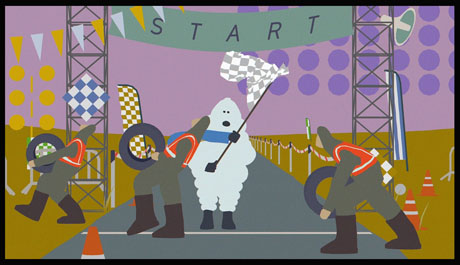
JM: A ride is a good word to use when describing your short because it’s about car racing. Have you always had an interest in car racing?
SJ: With my films, I often use some sort of sport… as a means of a framework. Car racing has always been my father’s interest, and motors in general. That’s the reason I chose that for “Sierra”.
JM: It’s quite a story. You incorporate some real footage in a television set. Tell me about that real black and white footage we see.
SJ: The black and white footage is an animation my father made when he was young. He was around 16 years old and he used a 16mm camera. He wanted to make an animation test, and he decided to use these toy cars to make this animation about this car race. When I started writing the story of “Sierra”, I really wanted to incorporate my father’s film. It also ended-up being the story of my relationship with my father. These things both came together.
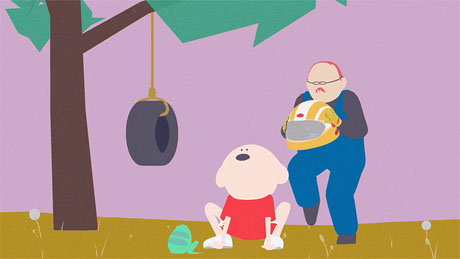
JM: Did you always know that you had that footage, or was it not until you started putting the story together that you found the footage?
SJ: I had seen it when I was around 7, I think. I had been thinking maybe it was one of the reasons I had become an animator, in a bigger sense. For me it’s important and has many layers. When coming up with my previous films, every time I was thinking, “Maybe now is the time to use this piece of footage.” But now that I made this, I got the courage to finally use this. It’s my most personal story yet.

Sander Joon
SJ: I have to thank my sound designer Matis Rei. And Matis Rei had actually been working on a live-action film about rallies. We had all the recordings of real race cars. So we used all these sounds. And Matis Rei also… did the final mix in my previous film, “Sounds Good”. I really wanted to collaborate with him again. These two things together — him being a specialist of car sounds and knowing how to incorporate the sensibilities of my animation — it was a perfect collaboration.
JM: And I love the color choices. Tell me a little bit about some of the reasoning behind these bold, distinct colors.
SJ: I always play around with the style of my films. My most concrete reference for the colors in the film is the graphics of the ’80s rallies. It started to affect the whole universe of the film’s language. I picked colors from there and this yellow and pink somehow stuck with me and gave me a nostalgic feeling I wanted to convey. It’s all around.
JM: You can really tell that nostalgic factor for sure. So, the boy becomes the tire, and it is absurd, but yet, there’s a real point to it. What was your intention for this major twist?
SJ: It’s quite a surprise when you see it. The father is pushing and forcing the child to pursue the father’s dreams of becoming really good at race driving. I came-up with this image. I was drawing a lot of cars and this boy and father. At some point I drew this image of the boy being inside of the tire, and it really fit the intention I had with the film. From then on, I started to invent the story. How could this happen… the boy is in the tire? It’s difficult and simple at the same time. I had this image but getting there somehow was a really big struggle for us, but we are really happy with where we ended-up.
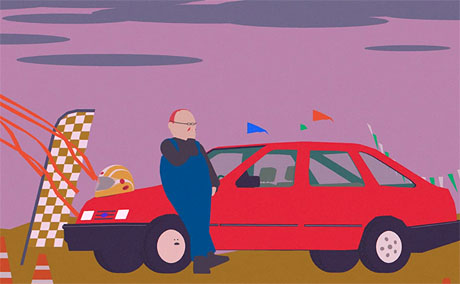
JM: It all makes sense, and the twist really works. And the extra layer to that is the character of the mother. That is realism as well — her reactions to everything going on. What was important to you about the way you wrote and crafted the mother character?
SJ: We really focused a lot on the mother character. In the beginning, she was more of a side character. I like that we incorporated more of her into the story. She becomes the most important character in parts of the film. I’m really happy she’s written into the story like this. She also reminds me of my mother. I’m really happy that you brought her up. I often talk about the film as being a son-father relationship, but there’s also a strong female character, which is important.
JM: You can feel your emotions towards all three of them. You can understand where all of them are coming from. And yet, there are issues with where the father is coming from. There are issues and understandings with everybody. Because this story is so personal for you, what was the most difficult part to convey through those characters?
SJ: The most difficult part is that it is based on my family. I think I conveyed my father as this really obsessive character. (laughs) It’s more of an exaggeration of my real life, but the feelings are really strong, from my childhood. I can’t really live-up to my father’s expectations. The thing that made me most nervous was to show it to my father and him feeling like he has been doing something wrong, but it’s actually not like this. It’s part of your journey, you know? You find your own thing by going through these phases and misunderstandings. What’s my father gonna think of the whole thing?
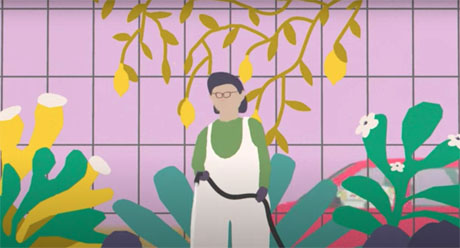
JM: And what did he think of it all?
SJ: He loved it! And I also had to explain it’s based on us but it’s also a dramatization, like films are. An interesting piece for the audience and more space for translating what’s happening.
JM: Towards the end of this short, you get us to a climactic, dramatic, effective moment. It shifts the tone in a way that works. How did you want us to get to the point and present that aspect?
SJ: This idea came-in a bit late, and to be honest we were actually quite afraid to end the film like this. But I was really happy when I came up with the idea because it’s really a nice mix of coming from a hectic, funny film into a serious tone. I really like how it affects the audience. It’s in the same language as what the film has previously been. It ties the whole family together. There are so many layers to this final moment. I was immediately in love with this idea. And it’s interesting how this came about. We had a piece of music that was intended for the middle part of the film where they are at the sea. It didn’t work for the sea part, but it worked for the ending part. Having this experience of collaboration with the composer and the sound designer… I like how everyone brought something unexpected into the film. This piece of music was this unexpected moment we used for the end scene.
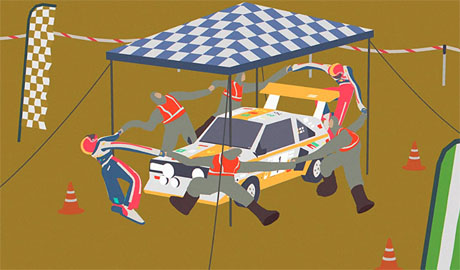
JM: When I was young, my uncle went to Estonia. He’s a professor. I remember seeing the pictures, learning the stories [of his travels there] and learning all about Estonia and how much he loved it there. What is the animation scene really like in Estonia?
SJ: Most of the Estonian animators are doing films like I’m doing. So it’s mostly absurd and funny films. We have a really great, surrealistic animation scene here. It has a really long history, going back to the time where we had the Soviet Era here. We had really great animators who broke through the Iron Wall, in their senses of ideas. In looking at the films, they feel really fresh. I really encourage everyone to look into Estonia’s animation history.
JM: Absolutely. What would it mean to you to be an Academy Award nominee… to get to go to the show, possibly win and be up on stage?
SJ: It would be a dream come true, honestly. Making animation is my biggest passion, and getting recognition like this would be amazing.
- INTERVIEW: Strap In For “Mars Express” - April 30, 2024
- INTERVIEW: Jeff Fowler On “Knuckles” And “Sonic 3” - April 22, 2024
- INTERVIEW: “Inside Out 2” Director And Producer On Pixar Sequel - April 16, 2024


 December 28th, 2022
December 28th, 2022  Jackson Murphy
Jackson Murphy  Posted in
Posted in  Tags:
Tags: 






